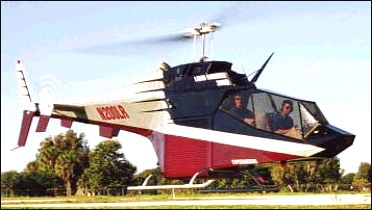Designed and built by Tom Navickas, the Load Ranger is primarily targeted at the aerial spraying market, but applications for medium freight hauling, law enforcement and special missions also being considered. Development started July 1996; first flight in April 1997 and certificated in the Experimental category; 30 flight hours logged by February 1998. Restricted use certification was aimed for third quarter of 1998, but no further information.
COSTS: US$500,000 (with Army surplus Allison T63 engine and drive train); US$1.5 million (with civil Allison 250-C18 engine and Bell 206 drive train).
DESIGN FEATURES: Two-blade metal main rotor with blade folding.
STRUCTURE: Chrome-alloy tubing skeleton with semi-monocoque skin; slab-sided fuselage with large centre cargo compartment accessed via a roller shutter.
LANDING GEAR: Tubular welded steel skids.
POWER PLANT: One Allison 250-C18 turboshaft, rated at 236kW for take-off. Max continuous rating 201kW. Fuel capacity in standard tank 190 litres; with auxiliary or ferry tank 758 litres.
ACCOMMODATION: Pilot and operator in tandem seats; freight compartment with typical load capacity of 907kg. Alternatively, six passengers can be seated side saddle in the cargo compartment with roller doors stowed.
AVIONICS: King KY96A radio; KT76A transponder and encoder; two-place intercom.
Jane's Helicopter Markets and Systems
| Technical data for Load Ranger 2000
Main rotor diameter: 10.15m,
tail rotor diameter: 1.58m,
fuselage length: 10.44m,
overall length, rotors turning: 11.79m,
overall width: 0.70m,
height to top of rotor head: 3.35m,
height over tailfin: 3.20m,
weight empty: 438kg,
max gross weight: 1520kg,
useful internal load: 1081kg,
external slung load: 1045kg,
never-exceed speed: 278km/h,
hover ceiling, IGE: 2745m,
hover ceiling, OGE: 1065m,
service ceiling: 4725m,
range, with max fuel: 547km
|





